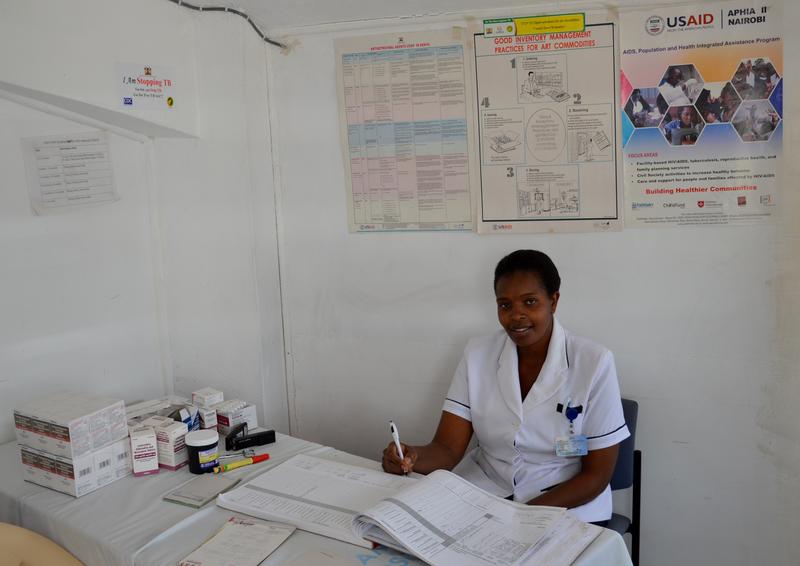
© 2013 Alfredo L Fort, Courtesy of Photoshare
By Francis (Kofi) Aboagye-Nyame, SIAPS Director
You can’t put a price tag on health, but we do have budgets that determine what we can spend to help countries improve theirs. At SIAPS, that means we need to look closely at the impact each dollar we spend has on achieving our goal: strengthening the management of essential medicines and supplies so they reach the people who need them and are used rationally. Here are some of the evidence-driven activities SIAPS has been pursuing, with their results.
Increasing global health security
As Bill Gates recently noted, foreign aid keeps people safe and makes the world more stable. The three countries most affected by the Ebola epidemic—Guinea, Sierra Leone, and Liberia—had weak health systems that provided little or no warning of the impending epidemic and few resources with which to fight quickly.
In Sierra Leone, Ebola destroyed the country’s already fragile health system. Under a special USAID-funded project, SIAPS is helping the government establish leadership and sound governance in the pharmaceutical sector to promote long-term stability and sustainable pharmaceutical management systems. We trained 24 pharmacists from around the country on how to lead and manage well in contingencies. SIAPS also helped create a monitoring and support system for health facilities that enables them to maintain a stable and efficient supply of medicines and related products and properly train staff—many of whom are volunteers—in how to use them. Similar system strengthening projects in Guinea, Mali, and Benin have promoted information and resource sharing in the region.
Pushing back against antimicrobial resistance (AMR) is also critical to containing diseases. To that end, SIAPS has implemented activities in nearly 20 countries that directly or indirectly contribute to AMR containment, such as helping countries establish regulatory systems, national action plans, standard treatment guidelines, and essential medicines lists. Preventing AMR is a boon to the global economy, too—the World Bank estimates that AMR could cost as much as USD 3.4 trillion by 2030.
Improving health outcomes
Comprehensive, effective medical treatments must include access to and availability of prescribed medicines and ensure that they are used appropriately. A well-run pharmaceutical supply chain helps prevent waste and stock-outs, which can do great harm. Interrupting treatment for a disease can hasten its spread and increase the mortality rate and the length and severity of illness, disease transmission, and drug resistance. In Kenya, TB treatment interruption cost the country millions of dollars in its impact on health services, families, and society in general. With technical support from SIAPS, Kenya’s National Tuberculosis, Leprosy, and Lung Disease Program advocated for and received emergency government funding to prevent stock-outs. That’s estimated to have saved more than 7,000 lives and prevented the development of more than 1,000 cases of drug-resistant TB and more than 400 new infections. It all translates to a savings of USD 25 million in health service costs and USD 88 million in household and society costs—a total of USD 113 million.
Sharing best practices
In 2015, USAID partnered with Johnson & Johnson to distribute the company’s donation of bedaquiline—a new treatment for drug-resistant tuberculosis—to low-income countries. Because bedaquiline requires active safety monitoring, SIAPS provides technical assistance to countries involved in the donation program to ensure proper use, monitor adverse reactions, and optimize patient safety. That included developing PViMS, a web-based application that helps track adverse events and health outcomes. SIAPS has helped five countries roll out the drug to date.
In May, SIAPS trained disaster relief workers in the Middle East to safely and efficiently manage pharmaceutical supplies that are funded by USAID’s Office of Foreign Disaster Assistance. The supplies are intended to help those affected by conflicts in Syria and Yemen.
Promoting data-driven decision making
Functioning information systems promote timely, appropriate, and cost-effective decision making for procuring, stocking, and prescribing medicines; ensuring their availability; monitoring their safety; and avoiding waste. Web-based dashboards and downloadable tools, backed by policy initiatives and driven by local needs, are helping pharmaceutical system managers at every juncture.
For example, Togo used OSPSIDA, an early warning system, to better manage HIV and AIDS commodities. The dashboard captures, track, aggregates, and disseminates patient data and stock information on antiretrovirals, rapid test kits, and other HIV and AIDS commodities. The country reached a 100% reporting rate within a year, up from 20%, and greatly reduced the incidence of commodity stock-outs. The QuanTB forecasting and quantification tool allowed the National Tuberculosis Program in Bangladesh to defer or cancel some unnecessary medicine shipments and redistribute them to other countries, resulting in an estimated savings of approximately USD 900,000.
SIAPS has helped countries build frameworks to track drug safety and adverse outcomes and ensure the quality of medicines and services. In Ethiopia, SIAPS helped develop an electronic medicine information registration system to increase the efficiency, transparency, and accountability of the marketing approval process, based on the SIAPS medicines registration tool, Pharmadex. The project also helped create a system to increase reporting of adverse drug events. Notably, these efforts have led to several regulatory actions, including recalls, production stops, and quality investigations of certain products.
Those are but a few of the results we’re tracking. Meanwhile, we’re improving how we measure impact. My colleagues at SIAPS have proposed a definition for a pharmaceutical system and defined what it means to strengthen it so that we can better measure the outcomes of our investments and efforts (see the paper in Health Policy and Planning).We’re also working on a tool to help countries gauge the strength and resilience of their pharmaceutical systems and decide where it makes sense to invest in them.

